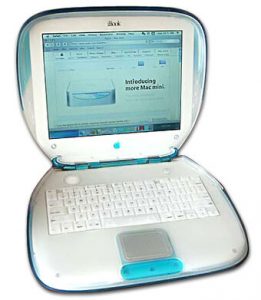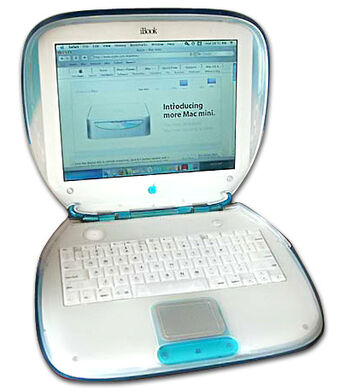
iBook is a line of laptop computers designed, manufactured, and sold by Apple Computer, Inc. from 1999 to 2006. The line targeted entry-level, consumer and education markets, with lower specifications and prices than the PowerBook, Apple’s higher-end line of laptop computers. It was the first mass consumer product to offer Wi-Fi network connectivity, which was then branded by Apple as AirPort.[1][2]
The iBook had three different designs during its lifetime. The first, known as the “Clamshell”, was inspired by the design of Apple’s popular iMac line at the time. It was a significant departure from previous portable computer designs due to its shape, bright colors, incorporation of a handle into the casing, lack of a display closing latch, lack of a hinged cover over the external ports and built-in wireless networking. Two years later, the second generation abandoned the original form factor in favor of a more conventional, rectangular design. In October 2003, the third generation was introduced, adding a PowerPC G4 chip, USB 2.0 and a slot-loading drive.
They were very popular in education, with Henrico County Public Schools being the first of many school systems in the United States to distribute one to every student.
Apple replaced the iBook line with the MacBook in May 2006 during the Mac transition to Intel processors.
In the late 1990s, Apple was trimming its product line from the bewildering variety of intersecting Performa, Quadra, LC, Power Macintosh and PowerBook models to a simplified “four box” strategy: desktop and portable computers, each in both consumer and professional models. Three boxes of this strategy were already in place: The newly introduced iMac was the consumer desktop, the Blue and White G3 filled the professional desktop box, and the PowerBook line served as the professional portable line. This left only the consumer portable space empty, leading to much rumor on the Internet of potential designs and features. Putting an end to this speculation, on July 21, 1999, Steve Jobs unveiled the iBook G3 during the keynote presentation of Macworld Conference & Expo, New York City.
Like the iMac, the iBook G3 had a PowerPC G3 CPU, and no legacy Apple interfaces. USB, Ethernet, modem ports and an optical drive were standard. The ports were left uncovered along the left side, as a cover was thought to be fragile and unnecessary with the iBook’s new interfaces, which lacked the exposed pins of earlier connectors. When the lid was closed, the hinge kept it firmly shut, so there was no need for a latch on the screen. The hinge included an integrated carrying handle. Additional power connectors on the bottom surface allowed multiple iBook G3s to be charged on a custom-made rack. The iBook G3 was the first Mac to use Apple’s new “Unified Logic Board Architecture”, which condensed all of the machine’s core features into two chips, and added AGP and Ultra DMA support.
Video:
Here’s the actual item in my museum
<my photo>
The iBook G3 basics:
Color: Green | HDD: 60 GB | OS: MacOS 9 | Series: iBook

